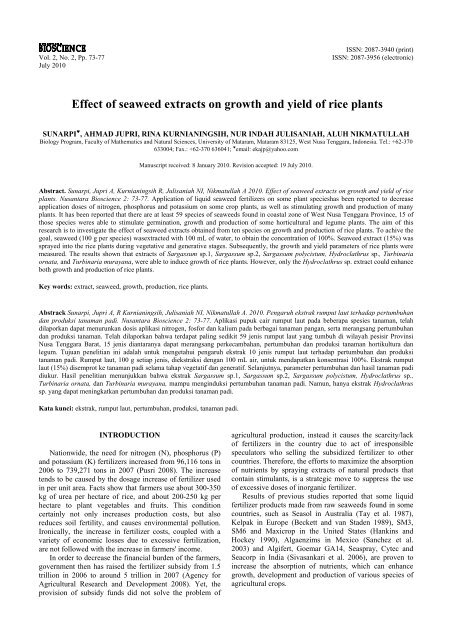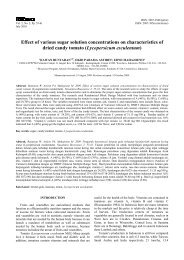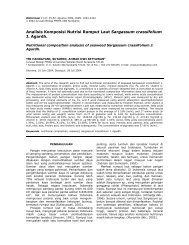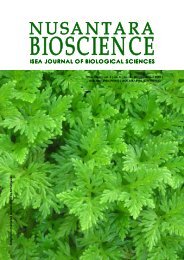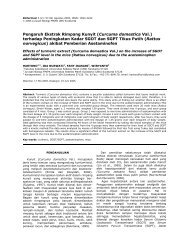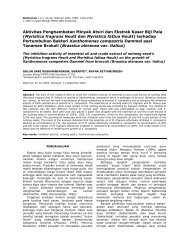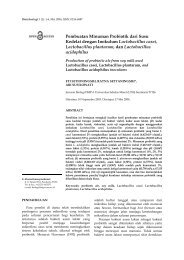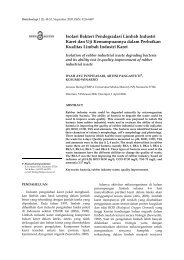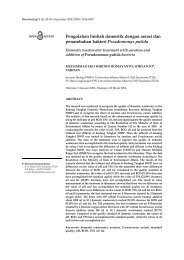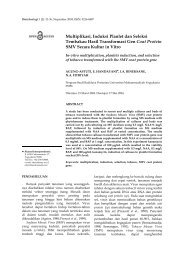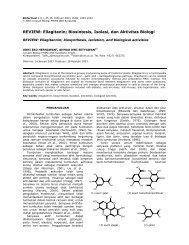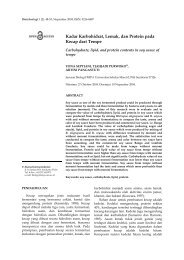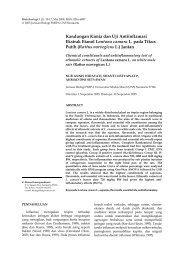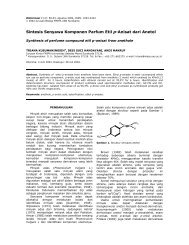Effect of seaweed extracts on growth and yield of rice plants
Effect of seaweed extracts on growth and yield of rice plants
Effect of seaweed extracts on growth and yield of rice plants
You also want an ePaper? Increase the reach of your titles
YUMPU automatically turns print PDFs into web optimized ePapers that Google loves.
Vol. 2, No. 2, Pp. 73-77July 2010ISSN: 2087-3940 (print)ISSN: 2087-3956 (electr<strong>on</strong>ic)<str<strong>on</strong>g>Effect</str<strong>on</strong>g> <str<strong>on</strong>g>of</str<strong>on</strong>g> <str<strong>on</strong>g>seaweed</str<strong>on</strong>g> <str<strong>on</strong>g>extracts</str<strong>on</strong>g> <strong>on</strong> <strong>growth</strong> <strong>and</strong> <strong>yield</strong> <str<strong>on</strong>g>of</str<strong>on</strong>g> <strong>rice</strong> <strong>plants</strong>SUNARPI ♥ , AHMAD JUPRI, RINA KURNIANINGSIH, NUR INDAH JULISANIAH, ALUH NIKMATULLAHBiology Program, Faculty <str<strong>on</strong>g>of</str<strong>on</strong>g> Mathematics <strong>and</strong> Natural Sciences, University <str<strong>on</strong>g>of</str<strong>on</strong>g> Mataram, Mataram 83125, West Nusa Tenggara, Ind<strong>on</strong>esia. Tel.: +62-370633004; Fax.: +62-370 636041; ♥ email: ekajp@yahoo.comManuscript received: 8 January 2010. Revisi<strong>on</strong> accepted: 19 July 2010.Abstract. Sunarpi, Jupri A, Kurnianingsih R, Julisaniah NI, Nikmatullah A 2010. <str<strong>on</strong>g>Effect</str<strong>on</strong>g> <str<strong>on</strong>g>of</str<strong>on</strong>g> <str<strong>on</strong>g>seaweed</str<strong>on</strong>g> <str<strong>on</strong>g>extracts</str<strong>on</strong>g> <strong>on</strong> <strong>growth</strong> <strong>and</strong> <strong>yield</strong> <str<strong>on</strong>g>of</str<strong>on</strong>g> <strong>rice</strong><strong>plants</strong>. Nusantara Bioscience 2: 73-77. Applicati<strong>on</strong> <str<strong>on</strong>g>of</str<strong>on</strong>g> liquid <str<strong>on</strong>g>seaweed</str<strong>on</strong>g> fertilizers <strong>on</strong> some plant specieshas been reported to decreaseapplicati<strong>on</strong> doses <str<strong>on</strong>g>of</str<strong>on</strong>g> nitrogen, phosphorus <strong>and</strong> potassium <strong>on</strong> some crop <strong>plants</strong>, as well as stimulating <strong>growth</strong> <strong>and</strong> producti<strong>on</strong> <str<strong>on</strong>g>of</str<strong>on</strong>g> many<strong>plants</strong>. It has been reported that there are at least 59 species <str<strong>on</strong>g>of</str<strong>on</strong>g> <str<strong>on</strong>g>seaweed</str<strong>on</strong>g>s found in coastal z<strong>on</strong>e <str<strong>on</strong>g>of</str<strong>on</strong>g> West Nusa Tenggara Province, 15 <str<strong>on</strong>g>of</str<strong>on</strong>g>those species weres able to stimulate germinati<strong>on</strong>, <strong>growth</strong> <strong>and</strong> producti<strong>on</strong> <str<strong>on</strong>g>of</str<strong>on</strong>g> some horticultural <strong>and</strong> legume <strong>plants</strong>. The aim <str<strong>on</strong>g>of</str<strong>on</strong>g> thisresearch is to investigate the effect <str<strong>on</strong>g>of</str<strong>on</strong>g> <str<strong>on</strong>g>seaweed</str<strong>on</strong>g> <str<strong>on</strong>g>extracts</str<strong>on</strong>g> obtained from ten species <strong>on</strong> <strong>growth</strong> <strong>and</strong> producti<strong>on</strong> <str<strong>on</strong>g>of</str<strong>on</strong>g> <strong>rice</strong> <strong>plants</strong>. To achive thegoal, <str<strong>on</strong>g>seaweed</str<strong>on</strong>g> (100 g per species) wasextracted with 100 mL <str<strong>on</strong>g>of</str<strong>on</strong>g> water, to obtain the c<strong>on</strong>centrati<strong>on</strong> <str<strong>on</strong>g>of</str<strong>on</strong>g> 100%. Seaweed extract (15%) wassprayed into the <strong>rice</strong> <strong>plants</strong> during vegetative <strong>and</strong> generative stages. Subsequently, the <strong>growth</strong> <strong>and</strong> <strong>yield</strong> parameters <str<strong>on</strong>g>of</str<strong>on</strong>g> <strong>rice</strong> <strong>plants</strong> weremeasured. The results shown that <str<strong>on</strong>g>extracts</str<strong>on</strong>g> <str<strong>on</strong>g>of</str<strong>on</strong>g> Sargassum sp.1, Sargassum sp.2, Sargassum polycistum, Hydroclathrus sp., Turbinariaornata, <strong>and</strong> Turbinaria murayana, were able to induce <strong>growth</strong> <str<strong>on</strong>g>of</str<strong>on</strong>g> <strong>rice</strong> <strong>plants</strong>. However, <strong>on</strong>ly the Hydroclathrus sp. extract could enhanceboth <strong>growth</strong> <strong>and</strong> producti<strong>on</strong> <str<strong>on</strong>g>of</str<strong>on</strong>g> <strong>rice</strong> <strong>plants</strong>.Key words: extract, <str<strong>on</strong>g>seaweed</str<strong>on</strong>g>, <strong>growth</strong>, producti<strong>on</strong>, <strong>rice</strong> <strong>plants</strong>.Abstrack Sunarpi, Jupri A, R Kurnianingsih, Julisaniah NI, Nikmatullah A. 2010. Pengaruh ekstrak rumput laut terhadap pertumbuh<strong>and</strong>an produksi tanaman padi. Nusantara Bioscience 2: 73-77. Aplikasi pupuk cair rumput laut pada beberapa spesies tanaman, telahdilaporkan dapat menurunkan dosis aplikasi nitrogen, fosfor dan kalium pada berbagai tanaman pangan, serta merangsang pertumbuh<strong>and</strong>an produksi tanaman. Telah dilaporkan bahwa terdapat paling sedikit 59 jenis rumput laut yang tumbuh di wilayah pesisir ProvinsiNusa Tenggara Barat, 15 jenis diantaranya dapat merangsang perkecambahan, pertumbuhan dan produksi tanaman hortikultura danlegum. Tujuan penelitian ini adalah untuk mengetahui pengaruh ekstrak 10 jenis rumput laut terhadap pertumbuhan dan produksitanaman padi. Rumput laut, 100 g setiap jenis, diekstraksi dengan 100 mL air, untuk mendapatkan k<strong>on</strong>sentrasi 100%. Ekstrak rumputlaut (15%) disemprot ke tanaman padi selama tahap vegetatif dan generatif. Selanjutnya, parameter pertumbuhan dan hasil tanaman padidiukur. Hasil penelitian menunjukkan bahwa ekstrak Sargassum sp.1, Sargassum sp.2, Sargassum polycistum, Hydroclathrus sp.,Turbinaria ornata, dan Turbinaria murayana, mampu menginduksi pertumbuhan tanaman padi. Namun, hanya ekstrak Hydroclathrussp. yang dapat meningkatkan pertumbuhan dan produksi tanaman padi.Kata kunci: ekstrak, rumput laut, pertumbuhan, produksi, tanaman padi.INTRODUCTIONNati<strong>on</strong>wide, the need for nitrogen (N), phosphorus (P)<strong>and</strong> potassium (K) fertilizers increased from 96,116 t<strong>on</strong>s in2006 to 739,271 t<strong>on</strong>s in 2007 (Pusri 2008). The increasetends to be caused by the dosage increase <str<strong>on</strong>g>of</str<strong>on</strong>g> fertilizer usedin per unit area. Facts show that farmers use about 300-350kg <str<strong>on</strong>g>of</str<strong>on</strong>g> urea per hectare <str<strong>on</strong>g>of</str<strong>on</strong>g> <strong>rice</strong>, <strong>and</strong> about 200-250 kg perhectare to plant vegetables <strong>and</strong> fruits. This c<strong>on</strong>diti<strong>on</strong>certainly not <strong>on</strong>ly increases producti<strong>on</strong> costs, but alsoreduces soil fertility, <strong>and</strong> causes envir<strong>on</strong>mental polluti<strong>on</strong>.Ir<strong>on</strong>ically, the increase in fertilizer costs, coupled with avariety <str<strong>on</strong>g>of</str<strong>on</strong>g> ec<strong>on</strong>omic losses due to excessive fertilizati<strong>on</strong>,are not followed with the increase in farmers' income.In order to decrease the financial burden <str<strong>on</strong>g>of</str<strong>on</strong>g> the farmers,government then has raised the fertilizer subsidy from 1.5trilli<strong>on</strong> in 2006 to around 5 trilli<strong>on</strong> in 2007 (Agency forAgricultural Research <strong>and</strong> Development 2008). Yet, theprovisi<strong>on</strong> <str<strong>on</strong>g>of</str<strong>on</strong>g> subsidy funds did not solve the problem <str<strong>on</strong>g>of</str<strong>on</strong>g>agricultural producti<strong>on</strong>, instead it causes the scarcity/lack<str<strong>on</strong>g>of</str<strong>on</strong>g> fertilizers in the country due to act <str<strong>on</strong>g>of</str<strong>on</strong>g> irresp<strong>on</strong>siblespeculators who selling the subsidized fertilizer to othercountries. Therefore, the efforts to maximize the absorpti<strong>on</strong><str<strong>on</strong>g>of</str<strong>on</strong>g> nutrients by spraying <str<strong>on</strong>g>extracts</str<strong>on</strong>g> <str<strong>on</strong>g>of</str<strong>on</strong>g> natural products thatc<strong>on</strong>tain stimulants, is a strategic move to suppress the use<str<strong>on</strong>g>of</str<strong>on</strong>g> excessive doses <str<strong>on</strong>g>of</str<strong>on</strong>g> inorganic fertilizer.Results <str<strong>on</strong>g>of</str<strong>on</strong>g> previous studies reported that some liquidfertilizer products made from raw <str<strong>on</strong>g>seaweed</str<strong>on</strong>g>s found in somecountries, such as Seasol in Australia (Tay et al. 1987),Kelpak in Europe (Beckett <strong>and</strong> van Staden 1989), SM3,SM6 <strong>and</strong> Maxicrop in the United States (Hankins <strong>and</strong>Hockey 1990), Algaenzims in Mexico (Sanchez et al.2003) <strong>and</strong> Algifert, Goemar GA14, Seaspray, Cytec <strong>and</strong>Seacorp in India (Sivasankari et al. 2006), are proven toincrease the absorpti<strong>on</strong> <str<strong>on</strong>g>of</str<strong>on</strong>g> nutrients, which can enhance<strong>growth</strong>, development <strong>and</strong> producti<strong>on</strong> <str<strong>on</strong>g>of</str<strong>on</strong>g> various species <str<strong>on</strong>g>of</str<strong>on</strong>g>agricultural crops.
742 (2): 73-77, July 2010West Nusa Tenggara (NTB) marine waters are reportedto have about 59 species <str<strong>on</strong>g>of</str<strong>on</strong>g> <str<strong>on</strong>g>seaweed</str<strong>on</strong>g> (Sunarpi et al. 2005,2006), 15 species <str<strong>on</strong>g>of</str<strong>on</strong>g> which can stimulate the germinati<strong>on</strong> <str<strong>on</strong>g>of</str<strong>on</strong>g>watermel<strong>on</strong> <strong>and</strong> sesame seeds (Sunarpi et al. 2007), the<strong>growth</strong> <str<strong>on</strong>g>of</str<strong>on</strong>g> bean <strong>plants</strong> (Sunarpi, 2008), the <strong>growth</strong> <strong>and</strong>producti<strong>on</strong> <str<strong>on</strong>g>of</str<strong>on</strong>g> tomato <strong>plants</strong> (Sunarpi et al. 2008; Sunarpi2008). In additi<strong>on</strong>, Tangaraju (2008) succeeded in loweringthe dose <str<strong>on</strong>g>of</str<strong>on</strong>g> urea fertilizer in <strong>rice</strong> <strong>plants</strong> by spraying<str<strong>on</strong>g>seaweed</str<strong>on</strong>g> extract to the <strong>plants</strong>. However, there is insufficientinformati<strong>on</strong> <strong>on</strong> the effect <str<strong>on</strong>g>of</str<strong>on</strong>g> <str<strong>on</strong>g>seaweed</str<strong>on</strong>g> extract which growsin tropical waters <strong>on</strong> the <strong>growth</strong> <strong>and</strong> <strong>yield</strong> <str<strong>on</strong>g>of</str<strong>on</strong>g> <strong>rice</strong>. Given theaforementi<strong>on</strong>ed facts, the study aims to determine theeffect <str<strong>on</strong>g>of</str<strong>on</strong>g> several types <str<strong>on</strong>g>of</str<strong>on</strong>g> <str<strong>on</strong>g>seaweed</str<strong>on</strong>g> <str<strong>on</strong>g>extracts</str<strong>on</strong>g> <strong>on</strong> <strong>growth</strong> <strong>and</strong><strong>yield</strong> <str<strong>on</strong>g>of</str<strong>on</strong>g> <strong>rice</strong>. The results showed that the extract <str<strong>on</strong>g>of</str<strong>on</strong>g><str<strong>on</strong>g>seaweed</str<strong>on</strong>g> Sargassum sp.1, Sargassum sp.2, Sargassumpolycistum, Hydroclathrus sp., Turbinaria ornata, <strong>and</strong>Turbinaria murayana are able to induce vegetative <strong>growth</strong><str<strong>on</strong>g>of</str<strong>on</strong>g> <strong>rice</strong> <strong>plants</strong>. However, <strong>on</strong>ly the extract <str<strong>on</strong>g>of</str<strong>on</strong>g> Hydroclathrussp. that influences the <strong>growth</strong> <strong>and</strong> <strong>yield</strong> <str<strong>on</strong>g>of</str<strong>on</strong>g> <strong>rice</strong>. This hasimplicati<strong>on</strong>s for efforts to reduce the dose <str<strong>on</strong>g>of</str<strong>on</strong>g> NPK fertilizeruse, so it can lower the producti<strong>on</strong> costs <strong>and</strong> reduceenvir<strong>on</strong>mental polluti<strong>on</strong> <strong>on</strong> <strong>rice</strong> <strong>plants</strong>.MATERIALS AND METHODSDesign, time <strong>and</strong> place <str<strong>on</strong>g>of</str<strong>on</strong>g> studyThe study was designed using completely r<strong>and</strong>omizeddesign (CRD), which c<strong>on</strong>sists <str<strong>on</strong>g>of</str<strong>on</strong>g> treatment <str<strong>on</strong>g>of</str<strong>on</strong>g> ten kinds <str<strong>on</strong>g>of</str<strong>on</strong>g><str<strong>on</strong>g>seaweed</str<strong>on</strong>g> extract, which is Turbinaria murayana,Turbinaria ornata, Sargassum sp.1, Sargassum sp.2,Sargassum polycistum, Ulva fasciata, Ulva ferticulata,Padina sp., Chaetomorpha sp., <strong>and</strong> Hydroclatrus sp. Thestudy was c<strong>on</strong>ducted in July-November 2009. Sampleswere taken from several sampling points in the sea <str<strong>on</strong>g>of</str<strong>on</strong>g>Lombok Isl<strong>and</strong>. The <str<strong>on</strong>g>seaweed</str<strong>on</strong>g> extracti<strong>on</strong> was performed atthe Laboratory <str<strong>on</strong>g>of</str<strong>on</strong>g> Imunobiology, Faculty <str<strong>on</strong>g>of</str<strong>on</strong>g> Mathematics<strong>and</strong> Natural Sciences, Mataram University. Rice planting<strong>and</strong> treatment were d<strong>on</strong>e in plastic house at Jatisela Village,Gunung Sari Subdistrict, West Lombok District, WestNusa Tenggara.Preparati<strong>on</strong> <str<strong>on</strong>g>of</str<strong>on</strong>g> <str<strong>on</strong>g>seaweed</str<strong>on</strong>g> extractSeaweed that has been collected <strong>on</strong> Lombok sea waters,i.e. Turbinaria murayana, Turbinaria ornata, Sargassumsp.1, Sargassum sp.2, Sargassum polycistum, Ulvafasciata, Ulva ferticulata, Padina sp., Chaetomorpha sp.,<strong>and</strong> Hydroclatrus sp., eachwas weighed as much as 100grams, cut into pieces <strong>and</strong> placed in the blender. After that,100 mL <str<strong>on</strong>g>of</str<strong>on</strong>g> distilled water was added ( ratio <str<strong>on</strong>g>of</str<strong>on</strong>g> 1:1 (w/v)),the mixture then blended until smooth, <strong>and</strong> filtered usingfilter paper. The slurry was centrifuged for 5 minutes at4°C at 5000 rpm speed. Following this, the supernatant wastransferred to a Falc<strong>on</strong> tube (designated as an extract with100% c<strong>on</strong>centrati<strong>on</strong>). Finally, 15% extract was prepared bymixing 15 mL <str<strong>on</strong>g>of</str<strong>on</strong>g> it into 85 mL <str<strong>on</strong>g>of</str<strong>on</strong>g> water.Planting <strong>and</strong> plant treatmentThe medium used in this study is potting mix composed<str<strong>on</strong>g>of</str<strong>on</strong>g> soil, s<strong>and</strong> <strong>and</strong> manure (1:1:1 (w.w). The threecomp<strong>on</strong>ents was then homogeneously mixed, weighed 8pounds, <strong>and</strong> put in a plastic pot (size <str<strong>on</strong>g>of</str<strong>on</strong>g> 5 L). Rice seedswere showed by spreading them in the nursery potsc<strong>on</strong>taining planting medium as described previously. After21 days, <strong>rice</strong> seedlings were planted in the medium that hadbeen prepared in the pot, <strong>on</strong>e clump per pot. Inorganicfertilizers, NPK fertilizer each with a dose <str<strong>on</strong>g>of</str<strong>on</strong>g> 2.4 g urea,1.2 g KCl gTSP <strong>and</strong> 0:36 per pot, were applied to the pot14 days after transplanting. During the course <str<strong>on</strong>g>of</str<strong>on</strong>g>experimentati<strong>on</strong>, the plant was maintained e according toprocedure st<strong>and</strong>ards for paddy crop, from planting toharvesting the <strong>rice</strong> crop.Seaweed extract treatment was d<strong>on</strong>e by spraying thewhole plant ( 4 times, 2 times during the vegetative phase<strong>and</strong> 2 times during the generative phase). Spraying <strong>on</strong> thevegetative <strong>growth</strong> phase was d<strong>on</strong>e when the <strong>rice</strong> was 3weeks <strong>and</strong> 6 weeks after planting, with spray volume <str<strong>on</strong>g>of</str<strong>on</strong>g> 20<strong>and</strong> 30 mL per pot. During the generative phase thespraying was carried out <strong>on</strong> the time <str<strong>on</strong>g>of</str<strong>on</strong>g> flowering <strong>and</strong> fruitfilling, each spray volume was 50 mL per pot.Growth parameters observed were plant height, number <str<strong>on</strong>g>of</str<strong>on</strong>g>leaves, number <str<strong>on</strong>g>of</str<strong>on</strong>g> tillers <strong>and</strong> weight <str<strong>on</strong>g>of</str<strong>on</strong>g> stems <strong>and</strong> roots.Plant heigh was observed by measuring the plant heightfrom the base <str<strong>on</strong>g>of</str<strong>on</strong>g> the clump which was exactly above theground until the end <str<strong>on</strong>g>of</str<strong>on</strong>g> the highest grove. Number <str<strong>on</strong>g>of</str<strong>on</strong>g> leaveswas observed by counting the number <str<strong>on</strong>g>of</str<strong>on</strong>g> leaves <strong>on</strong> eachclump, while number <str<strong>on</strong>g>of</str<strong>on</strong>g> tillers was observed by countingthe number <str<strong>on</strong>g>of</str<strong>on</strong>g> puppies/tillers that grow from each clump.The observati<strong>on</strong> was carried out from 14 days afterplanting, with intervals <str<strong>on</strong>g>of</str<strong>on</strong>g> 3 days. eight <str<strong>on</strong>g>of</str<strong>on</strong>g> stems <strong>and</strong> rootswere measured after the completi<strong>on</strong> <str<strong>on</strong>g>of</str<strong>on</strong>g> all other rsobservati<strong>on</strong>. Observati<strong>on</strong>s were c<strong>on</strong>ducted by calculatingthe fresh weight <str<strong>on</strong>g>of</str<strong>on</strong>g> <strong>plants</strong>.The crop <strong>yield</strong> parameters observed were the number <str<strong>on</strong>g>of</str<strong>on</strong>g>panicles, number <str<strong>on</strong>g>of</str<strong>on</strong>g> grains (seeds), weight per 100 seeds,<strong>and</strong> weight <str<strong>on</strong>g>of</str<strong>on</strong>g> seed per clump/ The number <str<strong>on</strong>g>of</str<strong>on</strong>g> panicles wascalculated by counting the number <str<strong>on</strong>g>of</str<strong>on</strong>g> panicles in eachclump <str<strong>on</strong>g>of</str<strong>on</strong>g> <strong>plants</strong> per pot. Number <str<strong>on</strong>g>of</str<strong>on</strong>g> grains (seeds) perpanicle was observed by calculating the number <str<strong>on</strong>g>of</str<strong>on</strong>g> grains(seeds) per panicle in each clump while weight per 100seeds was observed by measuring the weight per 100 seeds.Weight <str<strong>on</strong>g>of</str<strong>on</strong>g> seeds per clump was observed measured bymeasuring the weight <str<strong>on</strong>g>of</str<strong>on</strong>g> seeds in each clump. All the dataobtained are expressed in the form <str<strong>on</strong>g>of</str<strong>on</strong>g> an average <str<strong>on</strong>g>of</str<strong>on</strong>g>replicati<strong>on</strong>s ± SE.Data analysisData were analyzed <strong>on</strong>ly by calculating the averagevalue <str<strong>on</strong>g>of</str<strong>on</strong>g> three replicati<strong>on</strong>s in each test, <strong>and</strong> presented ingraphical form.RESULTS AND DISCUSSIONVegetative <strong>growth</strong> <str<strong>on</strong>g>of</str<strong>on</strong>g> <strong>rice</strong>The effect <str<strong>on</strong>g>of</str<strong>on</strong>g> several kinds <str<strong>on</strong>g>of</str<strong>on</strong>g> <str<strong>on</strong>g>seaweed</str<strong>on</strong>g> <str<strong>on</strong>g>extracts</str<strong>on</strong>g> <strong>on</strong> the<strong>growth</strong> <strong>and</strong> producti<strong>on</strong> <str<strong>on</strong>g>of</str<strong>on</strong>g> paddy was observed bymeasuring some <strong>growth</strong> <strong>and</strong> <strong>yield</strong> parameters <str<strong>on</strong>g>of</str<strong>on</strong>g> <strong>rice</strong>
SUNARPI et al. – <str<strong>on</strong>g>Effect</str<strong>on</strong>g> <str<strong>on</strong>g>of</str<strong>on</strong>g> <str<strong>on</strong>g>seaweed</str<strong>on</strong>g> <strong>on</strong> <strong>rice</strong> <strong>growth</strong> 75following the treatments. Growth parameters observedwere plant height, leaf number, number <str<strong>on</strong>g>of</str<strong>on</strong>g> tillers, weightstems <strong>and</strong> roots.Most <str<strong>on</strong>g>of</str<strong>on</strong>g> the <str<strong>on</strong>g>seaweed</str<strong>on</strong>g> <str<strong>on</strong>g>extracts</str<strong>on</strong>g> tested did not givepositive resp<strong>on</strong>se to the <strong>rice</strong> plant height. They mostlydecreased the plant height while <strong>on</strong>ly the height <str<strong>on</strong>g>of</str<strong>on</strong>g> <strong>rice</strong>paddy treated with three <str<strong>on</strong>g>extracts</str<strong>on</strong>g>, Sargassum sp.1, Ulvaferticulata <strong>and</strong> Hydroclathrus sp., were not suppressed.Interestingly, the height <str<strong>on</strong>g>of</str<strong>on</strong>g> <strong>plants</strong> treated with extract <str<strong>on</strong>g>of</str<strong>on</strong>g>Sargassum sp.1 (91.67 cm)was slightly higher than thec<strong>on</strong>trol <strong>plants</strong> (91.00 cm) (Figure 1).Different phenomena is found in the number <str<strong>on</strong>g>of</str<strong>on</strong>g> leaves.Most <str<strong>on</strong>g>of</str<strong>on</strong>g> the <strong>plants</strong> that were given <str<strong>on</strong>g>seaweed</str<strong>on</strong>g> extracttreatments had 5-25 more leaves compared with c<strong>on</strong>trol<strong>plants</strong>. The highest average number <str<strong>on</strong>g>of</str<strong>on</strong>g> leaves was observedin Sargassum sp.1- <strong>and</strong> S. polycistum-treated <strong>plants</strong> , atwhich 100.33 leaves were found compared to 75.7 leavesin c<strong>on</strong>trol <strong>plants</strong> (Figure 2). The big difference in thenumber <str<strong>on</strong>g>of</str<strong>on</strong>g> leaves <strong>on</strong> the plant-treated with <str<strong>on</strong>g>extracts</str<strong>on</strong>g> <strong>and</strong>without the extract indicates the effect <str<strong>on</strong>g>of</str<strong>on</strong>g> <str<strong>on</strong>g>seaweed</str<strong>on</strong>g> <str<strong>on</strong>g>extracts</str<strong>on</strong>g><strong>on</strong> the number <str<strong>on</strong>g>of</str<strong>on</strong>g> leaves <str<strong>on</strong>g>of</str<strong>on</strong>g> <strong>rice</strong>. This phenomen<strong>on</strong> may bedue to the presence <str<strong>on</strong>g>of</str<strong>on</strong>g> active compounds, micro-<strong>and</strong>macr<strong>on</strong>utrients in the extract <str<strong>on</strong>g>of</str<strong>on</strong>g> <str<strong>on</strong>g>seaweed</str<strong>on</strong>g>s (macroalgaes),which can stimulate plant <strong>growth</strong> (Abetz 1980; Finnie <strong>and</strong>Van Staden 1985). Previously, it was suggested thatvarious species <str<strong>on</strong>g>of</str<strong>on</strong>g> marine algae found in nature orcommercially cultivated c<strong>on</strong>tain organic compounds whichactivity resemble the activity <str<strong>on</strong>g>of</str<strong>on</strong>g> a cytokinin, auxin <strong>and</strong>gibrellin (Crouch <strong>and</strong> Staden 1993). These compoundswere able to stimulate <strong>growth</strong> as a result <str<strong>on</strong>g>of</str<strong>on</strong>g> enhancement <str<strong>on</strong>g>of</str<strong>on</strong>g>protein synthesis <strong>and</strong> cell divisi<strong>on</strong>, <strong>and</strong> t mobilizati<strong>on</strong> <str<strong>on</strong>g>of</str<strong>on</strong>g>nutrients needing for <strong>growth</strong>Pascale 1993).The <str<strong>on</strong>g>seaweed</str<strong>on</strong>g> <str<strong>on</strong>g>extracts</str<strong>on</strong>g> increase the number <str<strong>on</strong>g>of</str<strong>on</strong>g> tillers <str<strong>on</strong>g>of</str<strong>on</strong>g><strong>rice</strong> <strong>plants</strong> (Figure 3). There were four kinds <str<strong>on</strong>g>of</str<strong>on</strong>g> <str<strong>on</strong>g>seaweed</str<strong>on</strong>g><str<strong>on</strong>g>extracts</str<strong>on</strong>g> that able to induce the formati<strong>on</strong> <str<strong>on</strong>g>of</str<strong>on</strong>g> <strong>rice</strong> planttillers. The highest number <str<strong>on</strong>g>of</str<strong>on</strong>g> tillers present in planttreatedwithHydroclathrus sp. (26.33 tillers), followed byTurbinaria ornata (25 new <strong>plants</strong>), while the averagenumber <str<strong>on</strong>g>of</str<strong>on</strong>g> tillers <strong>on</strong> c<strong>on</strong>trol <strong>plants</strong> was <strong>on</strong>ly about 18.Figure 1. The effect <str<strong>on</strong>g>of</str<strong>on</strong>g> <str<strong>on</strong>g>seaweed</str<strong>on</strong>g> extract to the height <str<strong>on</strong>g>of</str<strong>on</strong>g> <strong>rice</strong><strong>plants</strong>.Figure 2. The effect <str<strong>on</strong>g>of</str<strong>on</strong>g> <str<strong>on</strong>g>seaweed</str<strong>on</strong>g> <str<strong>on</strong>g>extracts</str<strong>on</strong>g> <strong>on</strong> the number <str<strong>on</strong>g>of</str<strong>on</strong>g>leaves <str<strong>on</strong>g>of</str<strong>on</strong>g> <strong>rice</strong> <strong>plants</strong>.Figure 3. The effect <str<strong>on</strong>g>of</str<strong>on</strong>g> <str<strong>on</strong>g>seaweed</str<strong>on</strong>g> <str<strong>on</strong>g>extracts</str<strong>on</strong>g> <strong>on</strong> the number <str<strong>on</strong>g>of</str<strong>on</strong>g>tillers <str<strong>on</strong>g>of</str<strong>on</strong>g> <strong>rice</strong> <strong>plants</strong>In regard to fresh weight <str<strong>on</strong>g>of</str<strong>on</strong>g> stems <strong>and</strong> roots, <str<strong>on</strong>g>extracts</str<strong>on</strong>g>Hydrocalthrus sp. was significantly enhanced the <strong>growth</strong>by increasing fresh weight <str<strong>on</strong>g>of</str<strong>on</strong>g> <strong>rice</strong> plant stems <strong>and</strong> roots(Figure 4). Hydrocalthrus sp.-treated <strong>plants</strong> has an averageweight <str<strong>on</strong>g>of</str<strong>on</strong>g> 190.5 g ( the weight <str<strong>on</strong>g>of</str<strong>on</strong>g> c<strong>on</strong>trol plant is <strong>on</strong>ly130.87 g) <strong>and</strong> roots fresh weight <str<strong>on</strong>g>of</str<strong>on</strong>g> 51 g (the weight <str<strong>on</strong>g>of</str<strong>on</strong>g>c<strong>on</strong>trol plant is 39.3 g).Plant weight is affected by the c<strong>on</strong>centrati<strong>on</strong> <str<strong>on</strong>g>of</str<strong>on</strong>g>nutrients, as well as the quantity <str<strong>on</strong>g>of</str<strong>on</strong>g> photosynthetic products<str<strong>on</strong>g>of</str<strong>on</strong>g> the plant. Seaweed extract applicati<strong>on</strong> <strong>on</strong> plant issuggested to capable <str<strong>on</strong>g>of</str<strong>on</strong>g> increasing nutrient c<strong>on</strong>centrati<strong>on</strong>sin the leaves, through involvement <str<strong>on</strong>g>of</str<strong>on</strong>g> <strong>growth</strong> horm<strong>on</strong>e inthe process <str<strong>on</strong>g>of</str<strong>on</strong>g> nutrients absorpti<strong>on</strong> <strong>and</strong> movements in aplant, thus increasing the weight <str<strong>on</strong>g>of</str<strong>on</strong>g> the plant. . It wasreported in other systems that <str<strong>on</strong>g>seaweed</str<strong>on</strong>g> extract known <str<strong>on</strong>g>of</str<strong>on</strong>g>Ascophyllum nodosum c<strong>on</strong>tains <strong>growth</strong> horm<strong>on</strong>es, namelyIAA, while brown alga S. heterophyllum c<strong>on</strong>tains sitokinin(Crouch <strong>and</strong> Staden 1993). On additi<strong>on</strong>, Smith <strong>and</strong> Staden(1984) found that cytokinin activity was higher in <strong>plants</strong>treated with <str<strong>on</strong>g>seaweed</str<strong>on</strong>g> extract compared to the c<strong>on</strong>troluntreated<strong>plants</strong>.Producti<strong>on</strong> <str<strong>on</strong>g>of</str<strong>on</strong>g> <strong>rice</strong><str<strong>on</strong>g>Effect</str<strong>on</strong>g> <str<strong>on</strong>g>of</str<strong>on</strong>g> <str<strong>on</strong>g>seaweed</str<strong>on</strong>g> extract treatment <strong>on</strong> <strong>rice</strong> was alsoobserved in the <strong>rice</strong> product. . In this study, several <strong>yield</strong>parameters observed were the number <str<strong>on</strong>g>of</str<strong>on</strong>g> panicles, number<str<strong>on</strong>g>of</str<strong>on</strong>g> grains (seeds) in each panicle, <strong>and</strong> weight per 100 seeds.The number <str<strong>on</strong>g>of</str<strong>on</strong>g> panicles formed depends <strong>on</strong> the number <str<strong>on</strong>g>of</str<strong>on</strong>g>tillers present in every plant <strong>rice</strong>. The number <str<strong>on</strong>g>of</str<strong>on</strong>g> panicles
762 (2): 73-77, July 2010that were form will be directly proporti<strong>on</strong>al to the number<str<strong>on</strong>g>of</str<strong>on</strong>g> tillers came out in the <strong>rice</strong> plant. As explainedpreviously that most types <str<strong>on</strong>g>of</str<strong>on</strong>g> <str<strong>on</strong>g>seaweed</str<strong>on</strong>g> extract give a quitepositive influence <strong>on</strong> the <strong>growth</strong> <str<strong>on</strong>g>of</str<strong>on</strong>g> <strong>rice</strong> seedlings. In linewith these c<strong>on</strong>diti<strong>on</strong>s, the number <str<strong>on</strong>g>of</str<strong>on</strong>g> panicles <strong>on</strong> the planttreatedwith <str<strong>on</strong>g>seaweed</str<strong>on</strong>g> <str<strong>on</strong>g>extracts</str<strong>on</strong>g> were higher than the c<strong>on</strong>trol<strong>plants</strong> (without extract). Plants that have the most number<str<strong>on</strong>g>of</str<strong>on</strong>g> panicles is a plant-treated with Hydroclathrus sp. extractwith an average number <str<strong>on</strong>g>of</str<strong>on</strong>g> panicles <str<strong>on</strong>g>of</str<strong>on</strong>g> 26.33, while thec<strong>on</strong>trol <strong>plants</strong> has <strong>on</strong>ly 18 units (Figure 5). Seaweedextract-treated <strong>plants</strong> were capable to produce more grain(seed) per penicle (Figure 6). C<strong>on</strong>trol <strong>plants</strong> were <strong>on</strong>lycapable <str<strong>on</strong>g>of</str<strong>on</strong>g> producing 160.11 grain per penicle, while the<strong>plants</strong> which were given Hydroclthrus sp. <str<strong>on</strong>g>seaweed</str<strong>on</strong>g> extractproduced 171.11 grains per penicle. Although <str<strong>on</strong>g>seaweed</str<strong>on</strong>g><str<strong>on</strong>g>extracts</str<strong>on</strong>g> enhanced the number <str<strong>on</strong>g>of</str<strong>on</strong>g> seeds per penicle, they didnot alter grain weight. In most cases, they promoted similar100 grain weight per penicle ot in other case they evendecreased it Figure 7).ABFigure 4. The effect <str<strong>on</strong>g>of</str<strong>on</strong>g> <str<strong>on</strong>g>seaweed</str<strong>on</strong>g> extract to the brangkasan weight <str<strong>on</strong>g>of</str<strong>on</strong>g> the <strong>rice</strong> plant: A. Roots, B. Stem.Figure 5. The effect <str<strong>on</strong>g>of</str<strong>on</strong>g> <str<strong>on</strong>g>seaweed</str<strong>on</strong>g> extract to the amount <str<strong>on</strong>g>of</str<strong>on</strong>g> <strong>rice</strong>panicleFigure 6. The effect <str<strong>on</strong>g>of</str<strong>on</strong>g> <str<strong>on</strong>g>seaweed</str<strong>on</strong>g> extract <strong>on</strong> number <str<strong>on</strong>g>of</str<strong>on</strong>g> grains(seeds) <strong>on</strong> each panicle <strong>rice</strong> <strong>plants</strong>ABFigure 7. The effect <str<strong>on</strong>g>of</str<strong>on</strong>g> <str<strong>on</strong>g>seaweed</str<strong>on</strong>g> <str<strong>on</strong>g>extracts</str<strong>on</strong>g> <strong>on</strong> seed weight <str<strong>on</strong>g>of</str<strong>on</strong>g> <strong>rice</strong> <strong>plants</strong>; A. Weight per 100 seeds, B. Heavy seeds /clump.
SUNARPI et al. – <str<strong>on</strong>g>Effect</str<strong>on</strong>g> <str<strong>on</strong>g>of</str<strong>on</strong>g> <str<strong>on</strong>g>seaweed</str<strong>on</strong>g> <strong>on</strong> <strong>rice</strong> <strong>growth</strong> 77The opposite occurs <strong>on</strong> the weight <str<strong>on</strong>g>of</str<strong>on</strong>g> grain (seed) ineach clump <str<strong>on</strong>g>of</str<strong>on</strong>g> <strong>rice</strong> <strong>plants</strong>. The highest grain weight in eachcluster was observed in plant treated with extractHydroclathrus sp. which is about 66.89 g, while c<strong>on</strong>trol<strong>plants</strong> weighed <strong>on</strong>ly about 46.80 g (Figure 7). Takentogether, the results indicate that applicati<strong>on</strong> <str<strong>on</strong>g>of</str<strong>on</strong>g> <str<strong>on</strong>g>extracts</str<strong>on</strong>g>from some <str<strong>on</strong>g>seaweed</str<strong>on</strong>g> species could promote <strong>growth</strong> <strong>and</strong>producti<strong>on</strong> <str<strong>on</strong>g>of</str<strong>on</strong>g> <strong>rice</strong> paddy <strong>and</strong> this imply that ut may bepossibility to reduce the inorganic fertilizers dosage for <strong>rice</strong>paddy cultivati<strong>on</strong>.CONCLUSIONS AND RECOMENDATIONSSeaweed <str<strong>on</strong>g>extracts</str<strong>on</strong>g> that are able to induce vegetative<strong>growth</strong> <str<strong>on</strong>g>of</str<strong>on</strong>g> <strong>rice</strong> <strong>plants</strong> are the extract <str<strong>on</strong>g>of</str<strong>on</strong>g> Sargassum sp.1,Sargassum sp.2, Sargassum polycistum, Hydroclathrus sp.,Turbinaria ornata, <strong>and</strong> Turbinaria murayana. However,<strong>on</strong>ly <str<strong>on</strong>g>extracts</str<strong>on</strong>g> Hydroclathrus sp. that can stimulate both<strong>growth</strong> <strong>and</strong> <strong>yield</strong> <str<strong>on</strong>g>of</str<strong>on</strong>g> <strong>rice</strong>. Further studies are now underwayto examine the effect <str<strong>on</strong>g>of</str<strong>on</strong>g> combined <str<strong>on</strong>g>extracts</str<strong>on</strong>g> <strong>and</strong> solidfracti<strong>on</strong>s <str<strong>on</strong>g>of</str<strong>on</strong>g> <str<strong>on</strong>g>seaweed</str<strong>on</strong>g> <strong>on</strong> <strong>growth</strong> <strong>and</strong> producti<strong>on</strong> <str<strong>on</strong>g>of</str<strong>on</strong>g> <strong>rice</strong><strong>plants</strong> as well as to test the effect <str<strong>on</strong>g>of</str<strong>on</strong>g> <str<strong>on</strong>g>seaweed</str<strong>on</strong>g> solid <strong>and</strong>liquid fracti<strong>on</strong>s <strong>on</strong> NPK fertilizer use efficiency in <strong>rice</strong>cultivati<strong>on</strong>.ACKNOWLEDGEMENTSThe research team would like to thank DP2M HigherEducati<strong>on</strong>, Ministry <str<strong>on</strong>g>of</str<strong>on</strong>g> Nati<strong>on</strong>al Educati<strong>on</strong>, RI for allocatedresearch grant in 2009 to support this research. We wouldalso like to extend our thanks to the Chairman <str<strong>on</strong>g>of</str<strong>on</strong>g> theResearch Institute <str<strong>on</strong>g>of</str<strong>on</strong>g> the University <str<strong>on</strong>g>of</str<strong>on</strong>g> Mataram r for alladministrative support enabling this research to bec<strong>on</strong>ducted. Thanks also go to the Dean <str<strong>on</strong>g>of</str<strong>on</strong>g> Science, StateUniversity <str<strong>on</strong>g>of</str<strong>on</strong>g> Mataram which give us permissi<strong>on</strong> to use anyfacilities <str<strong>on</strong>g>of</str<strong>on</strong>g> Immunobiology Laboratory, so that thisresearch can be c<strong>on</strong>ducted. Hopefully, all support isrecorded as a charity that will get rewarded accordingly byGod Almighty, amen.REFERENCESAbetz P. 1980. Seaweed extract: have they a place in Australianagriculture or horticulture? J Aust Inst Agric Sci 46: 23-29.Pusri. 2008. Data realizati<strong>on</strong> <str<strong>on</strong>g>of</str<strong>on</strong>g> producti<strong>on</strong>, c<strong>on</strong>sumpti<strong>on</strong>, export <strong>and</strong>import <str<strong>on</strong>g>of</str<strong>on</strong>g> fertilizer. www.APPI.or.id. [Ind<strong>on</strong>esia]Agency for Agricultural Research <strong>and</strong> Development. 2008. Policy analysis<str<strong>on</strong>g>of</str<strong>on</strong>g> capital, l<strong>and</strong> <strong>and</strong> water resources. www.litbang.deptan.go.id.[Ind<strong>on</strong>esia]Beckett RP, Van Staden J. 1989. The effect <str<strong>on</strong>g>of</str<strong>on</strong>g> <str<strong>on</strong>g>seaweed</str<strong>on</strong>g> c<strong>on</strong>centrate <strong>on</strong> the<strong>growth</strong> <strong>and</strong> <strong>yield</strong> <str<strong>on</strong>g>of</str<strong>on</strong>g> potassium stressed wheat. Plant Soil 116: 29-36.Crouch IJ, Van Staden J. 1993. Evidence <str<strong>on</strong>g>of</str<strong>on</strong>g> the presence <str<strong>on</strong>g>of</str<strong>on</strong>g> plant <strong>growth</strong>regulators in commercial <str<strong>on</strong>g>seaweed</str<strong>on</strong>g> product. Departement <str<strong>on</strong>g>of</str<strong>on</strong>g> Botany,University <str<strong>on</strong>g>of</str<strong>on</strong>g> Natal, RSA.Finnie JF, Van Staden J. 1985. The effect <str<strong>on</strong>g>of</str<strong>on</strong>g> <str<strong>on</strong>g>seaweed</str<strong>on</strong>g> c<strong>on</strong>centrate <strong>and</strong>applied horm<strong>on</strong>es <strong>on</strong> in vitro cultured tomato roots. J Plant Physiol120: 215-310.Hankins SD, Hockey HP. 1990. The effect <str<strong>on</strong>g>of</str<strong>on</strong>g> liquid <str<strong>on</strong>g>seaweed</str<strong>on</strong>g> extract fromAscophyllum nodosum (Fucales, Phaephyta) <strong>on</strong> the two-spotted redspider mite Tetranychus urticae. Hydrobiologia 204/205: 555-559.Pascale P, Claude J, Kloareg B, Lineart Y, Rochans C. 1993. Seaweedliquid fertilizer from Ascophyllum nodosum c<strong>on</strong>tains elicitor <str<strong>on</strong>g>of</str<strong>on</strong>g> plantd-glycanase. J Appl Phycol 5: 343-349.Sanchez JAV, Ilyina A, Mendez-Jimenez LP, Robledo-Torres V,Rodriguez-Herrera R, Canales-Lopez B, Rodriguez-Martinez J. 2003.Isolati<strong>on</strong> <str<strong>on</strong>g>of</str<strong>on</strong>g> microbial gropus from a <str<strong>on</strong>g>seaweed</str<strong>on</strong>g> extract <strong>and</strong> comparis<strong>on</strong><str<strong>on</strong>g>of</str<strong>on</strong>g> their effect <strong>on</strong> a <strong>growth</strong> <str<strong>on</strong>g>of</str<strong>on</strong>g> pepper culture (Capsicum annuum L.).Bect Mock 44: 92-96.Sivasankari S, Venkatesalu V, Anantharaj M, Ch<strong>and</strong>rasekaran M. 2006.<str<strong>on</strong>g>Effect</str<strong>on</strong>g> <str<strong>on</strong>g>of</str<strong>on</strong>g> <str<strong>on</strong>g>seaweed</str<strong>on</strong>g> extract <strong>on</strong> the <strong>growth</strong> <strong>and</strong> biochemical c<strong>on</strong>stituents<str<strong>on</strong>g>of</str<strong>on</strong>g> Vigna sinensis. Biores Technol 97: 1745-1751.Sunarpi, Jupri A, Suripto, Rusman, Suastika IBM. 2005. Seaweed speciesdiversity in West Nusa Tenggara. [Research Report]. Balai BudidayaLaut Lombok. Mataram. [Ind<strong>on</strong>esia]Sunarpi, Jupri A, Suripto, Rusman, Suastika IBM. 2006. Identificati<strong>on</strong> <str<strong>on</strong>g>of</str<strong>on</strong>g>strains <str<strong>on</strong>g>of</str<strong>on</strong>g> <str<strong>on</strong>g>seaweed</str<strong>on</strong>g> in the waters <str<strong>on</strong>g>of</str<strong>on</strong>g> Lombok using morphology <strong>and</strong>molecular marker <str<strong>on</strong>g>of</str<strong>on</strong>g> RAPD. Proceeding <str<strong>on</strong>g>of</str<strong>on</strong>g> the Ind<strong>on</strong>esianAquaculture, Jakarta, 2006. [Ind<strong>on</strong>esia]Sunarpi, Jupri A, Nurahman. 2007. Screening <str<strong>on</strong>g>of</str<strong>on</strong>g> West Nusa Tenggara<str<strong>on</strong>g>seaweed</str<strong>on</strong>g> that potential as raw materials <str<strong>on</strong>g>of</str<strong>on</strong>g> organic fertilizer. [ResearchReport]. Faculty <str<strong>on</strong>g>of</str<strong>on</strong>g> Mathematics <strong>and</strong> Natural Sciences, University <str<strong>on</strong>g>of</str<strong>on</strong>g>Mataram. Mataram. [Ind<strong>on</strong>esia]Sunarpi, Jupri A, Nurahman. 2008. Test <str<strong>on</strong>g>of</str<strong>on</strong>g> c<strong>on</strong>centrati<strong>on</strong> <strong>and</strong> time givingextract <str<strong>on</strong>g>of</str<strong>on</strong>g> some <str<strong>on</strong>g>seaweed</str<strong>on</strong>g> species <strong>on</strong> the <strong>growth</strong> <strong>and</strong> producti<strong>on</strong> <str<strong>on</strong>g>of</str<strong>on</strong>g>tomato. [Research Report]. Faculty <str<strong>on</strong>g>of</str<strong>on</strong>g> Mathematics <strong>and</strong> NaturalSciences, University <str<strong>on</strong>g>of</str<strong>on</strong>g> Mataram, Mataram. [Ind<strong>on</strong>esia]Smith BC, Van Staden J. 1984. The effect <str<strong>on</strong>g>of</str<strong>on</strong>g> <str<strong>on</strong>g>seaweed</str<strong>on</strong>g> c<strong>on</strong>centrate <strong>and</strong>fertizer <strong>on</strong> <strong>growth</strong> <strong>and</strong> the endogenous cytokinin c<strong>on</strong>tent <str<strong>on</strong>g>of</str<strong>on</strong>g> Phaseolusvulgaris. SA J Bot 3: 375.Tay SAB, Palni LMS, MacLeod JK. 1986. Identificati<strong>on</strong> <str<strong>on</strong>g>of</str<strong>on</strong>g> cytokinin in a<str<strong>on</strong>g>seaweed</str<strong>on</strong>g> extract. J Plant Growth Regul 5: 133-138.Thangaraju N. 2008. Efficacy <str<strong>on</strong>g>of</str<strong>on</strong>g> <str<strong>on</strong>g>seaweed</str<strong>on</strong>g> liquid fertilizers (SLFs) <str<strong>on</strong>g>of</str<strong>on</strong>g>Sargassum wightii Grev. <strong>and</strong> Ulva lactuca <strong>on</strong> the <strong>growth</strong> <strong>and</strong> <strong>yield</strong> <str<strong>on</strong>g>of</str<strong>on</strong>g>paddy (Oryza sativa L. var ADT 36) under greenhouse c<strong>on</strong>diti<strong>on</strong>s.Proceeding <str<strong>on</strong>g>of</str<strong>on</strong>g> The 11 th Internati<strong>on</strong>al C<strong>on</strong>ference <strong>on</strong> AppliedPhycology. Galway-Irel<strong>and</strong>, June 21-27, 2008.


